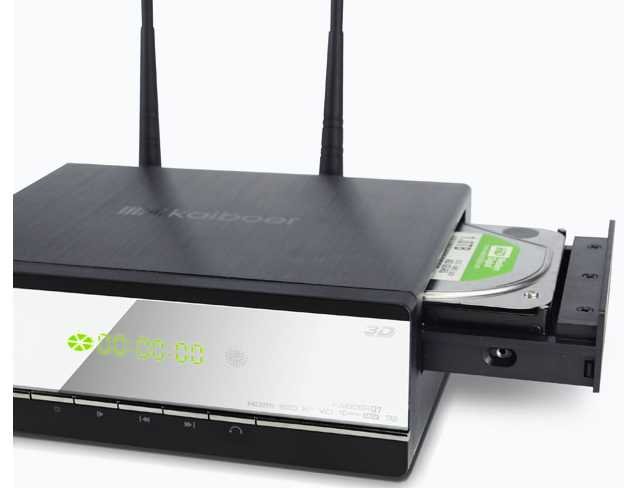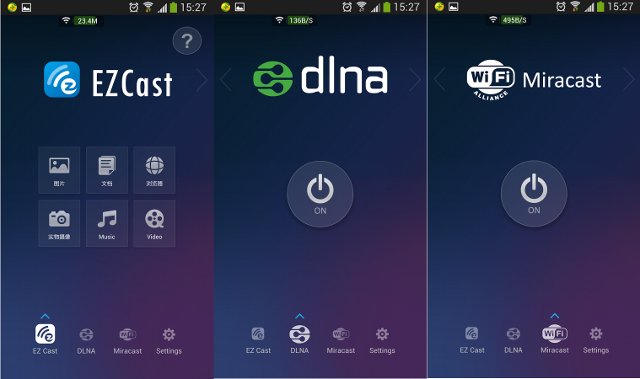Kaiboer Q7 is an upcoming Android 4.2 media player, a bit larger than usual, based on a dual core Cortex A7 SoC, probably AllWinner A20, that features two Wi-Fi antennas, a front panel with LCD display and buttons, and a bay for a 3.5″ SATA hard drive. AndroidPC.es reports the company did not provide the full specifications, but we still know the processor is based on a dual core Cortex A7 processor, and includes 4 USB ports, HDMI, composite and component video outputs, coaxial and optical SPDIF audio outputs, an RJ45 network connector, and on-off button. It’s quite nice to have a device with an internal 3.5″ hard drive, but one downside is the addition of an small fan to keep the device and hard drive cool. The device will run Android 4.2 with a custom interface called KIUI6.0. Price and availability are unknown at this point.
Texas Instruments OMAP5432 EVM Benchmarked Against ODROID-U2, BeagleBone Black, GK802… and an Intel Core i7-2600K based PC
Texas instruments and SVTronics announced an OMAP5 evaluation board a couple of months ago. The board features OMAP5432 dual Cortex A15, dual Cortex M4 SoC, 2GB RAM, a 4GB eMMC module, USB 3.0, SATA and more. SVTronics sent a board to Linux.com, where they wrote a short review, followed by an article benchmarking the OMAP5 EVM against AllWinner A10, Freescale i.MX6, Exynos 4412 Prime, and TI Sitara platforms, namely Cubieboard, GK802, ODROID-U2, and BeagleBone Black, all running Linux. Ben Martin, the writer, also benchmarked the board against a Linux PC powered by an Intel Core i7-2600K processor (4 cores, 8 thread, clocked at 3.4GHz, with a turbo frequency up to 3.8GHz). The board used was an early version, clocked at 800MHz, and later in September, all boards will be clocked at 1.5Ghz, so for benchmarks that stress the CPU, you could expect almost double the performance. With that in mind, […]
MCU Energy Efficiency Benchmark – Freescale KL02, Microchip PIC24, TI MSP430, and STMicro STM32L
Freescale has recently uploaded a video comparison the energy efficiency of several micro-controllers: Freescale Kinetis KL02, Texas Instruments MSP430, STMicro STM32L, and Microchip PIC24. Since it’s a Freescale video, we already know the winner, but the test they performed it still interesting, and it shows drastic performance differences between architectures. The used the following exact MCU for testing: Freescale MKL02Z32CAF4R – Cortex M0+ @ 48 MHz STMicro STM32L151RBT6 – Cortex M3 @ 32 MHz Microchip PIC24FJ128GA308 – 16-bit MCU @ 32 MHz Texas Instruments MSP430F5529 – 16-bit MCU @ 25 MHz Freescale did not really select tough competition such as NXP LPC800 Cortex M0+, but instead a Cortex M3 MCU, and older 16-bit MCUs. I don’t know if Microchip has a new generation of ultra low power 16-bit MCUs , but Texas Instruments, for example, launched MSP430 Wolverine MCUs at the end of last year. So this comparison may not be […]
Ugoos UM2 Android TV Stick Features Two Full Size USB Ports
Most Android HDMI TV dongles come with only one full size USB port, as well as some micro or mini USB ports. The user then has to use an external USB hub if he or she wants to connect standard USB keyboard and mouse, and ends up with some kind of cable mess. Ugoos UM2 mini PC does not have this issue as it comes with 2 full size USB ports. The rest of the specifications are standard for a quad core HDMI TV Stick: SoC – Rockchip RK3188 Quad core Cortex-A9 + Mali 400 MP4 GPU System Memory – 2GB DDR3 Storage – 8GB NAND Flash (Option for 16G/32G) + micro SD card slot (Up to 32GB) Connectivity – WiFi 802.11 b/g/n, Bluetooth (Version 4.0 TBC) Video Output – HDMI 1.3 Male USB – 2x USB Host ports + 1x micro USB port for power Power Supply – 5V/2A Dimension – […]
EPICT EPP-100 Android 4.2 Mini Projector
EPICT EPP-100 is a tiny Android 4.2 device with features similar to many Android mini PCs or set-top boxes, and is based on AllWinner A20 SoC with 512MB RAM and 4GB Flash, but the features that makes it different is a 35-lumens pico-projector capable of outputting an 80″ picture. Here are the specifications of the devices listed on Pandawill: SoC – AllWinner A20 Dual core ARM Cortex-A7 Dual-Core with ARM Mali-400 MP2 GPU System Memory – 512MB RAM Storage – 4GB NAND Flash + micro SD card slot (Up to 32GB) Projector – Resolution 800 x 480, 35 Lumens, Up to 80″ Connectivity – Wi-Fi 802.11 b/g/n, Bluetooth USB – 1x USB 2.0 Host, 1x micro USB OTG Audio – 3.5 mm jack for headphone Power – Standby Time: Up to one week Dimensions – 68 x 62 x 57mm Weight – 210g (without the stand) The package includes a […]
$249 Terasic SoCKit Development Kit Features Altera Cyclone V SX Dual Core A9 + FPGA SoC
There seems to be a lot a development going on around dual core A9 + FPGA SoCs from Xilinx or Altera these days, and Terasic has recently announced SoCKit, a development board based on Altera Cyclone V SX SoC with 2GB RAM (1GB for ARM cores, 1GB for FPGA), 110K logic elements, etc… Here are the specifications listed on Terasic website: FPGA Device – Cyclone V SX SoC—5CSXFC6D6F31C8NES: 110K LEs, 41509 ALMs 5140 M10K memory blocks 6 FPGA PLLs and 3 HPS PLLs 2 Hard Memory Controllers 3.125G Transceivers ARM-based hard processor system (HPS) @ 800 MHz, Dual-Core ARM Cortex-A9 MPCore Processor with 512 KB of shared L2 cache, 64 KB of scratch RAM, Multiport SDRAM controller (DDR2, DDR3, LPDDR1, and LPDDR2), and 8-channel direct memory access (DMA) controller Configuration and Debug: Quad Serial Configuration device – EPCQ256 for FPGA On-Board USB Blaster II (micro USB type B connector) Memory […]
$20 Boogie Board is an “Etch a Sketch” LCD Tablet
If you’re old enough (or have followed the US 2012 presidential race), you must know an Etch a Sketch is a drawing board that you can erase by shaking it. The Boogie Board LCD eWriter has basically the same functionality, but instead of using aluminum powder, it’s using a Reflex LCD display and a stylus, and instead of shaking it to erase content, you’ll just press a button. Like E-Ink, reflex LCD displays do not use power when content remains unchanged. The first version was released in 2010, and appears to be relatively easy to find in the US (online retailers, Wallmart…), but not so in the rest of the world. There are 5 versions of the Boogie Board, but the last 2 that will only be available for Xmas 2013: Original 8.5 – 8.6″ display, external adhesive magnets Original 10.5 – 10.5″ display, replaceable batteries Jot 8.5 – 8.6″ […]
EZCast Is a Wi-Fi Display Solution (Miracast, DLNA, etc..) to be Used With Actions Micro HDMI TV Dongles
This morning I’ve come across an interesting video via Google+ (in Chinese) that showcases the features of EZCast, an application that can be installed on Android or iOS, and supports screen mirroring, DLNA, and Miracast with HDMI TV Dongles designed by Actions Micro. The company is not to be confused with Actions Semi The company is a subsidiary of Actions Semi, an IC company that provides ATV6003 SoC used in HDMI TV Dongles such as iPush. If you’ve watched the video above, beside DLNA and Miracast, you’ve found out it can also be a nice presentation tools, allowing for PowerPoint slideshows, and notes writing via your smartphone. After further research, I found the application has recently been published on both Apple App Store and Google Play. The App description is only available in Chinese, but here’s the (unedited) Google Translation of the description: EZCast is a powerful home media sharing […]













